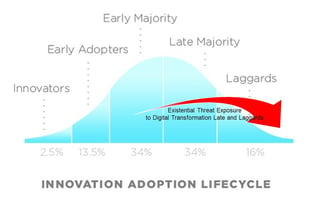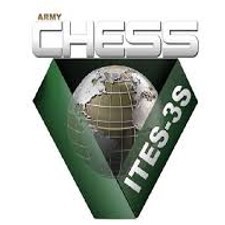My definition of digital transformation is leveraging information technology to disrupt traditional industry models and business practices to deliver exceptional customer and business value and create sustainable competitive advantage.
So, based on my definition, why is “digital transformation” such a hot topic today? How is digital transformation any different than the leveraging of information technology organizations have been doing over the last 10+ years? Why is digital transformaton an existential threat to technological laggards? Fair questions. And, that is indeed the driver of this blog post.
Shift from Competitive Advantage to Existential Threat
Traditionally, organizations that rapidly embrace and successfully deploy advances in information technology (often referred to as technological innovators and early adopters) create a short-term incremental competitive advantage in terms of organizational effectiveness and operational efficiency over the early majority, late majority and especially the technological laggards. However, the late and laggards managed to remain competitive from a customer perspective, albeit less efficiently, by utilizing a higher proportion of people resources than their more technologically advanced competitors.
 The short-term incremental competitive advantage enjoyed by the organizations that rapidly embraced and successfully deployed advances in information technology continued to widen over the late and laggards. Today, short-term is now long-term and incremental is now transformational.
The short-term incremental competitive advantage enjoyed by the organizations that rapidly embraced and successfully deployed advances in information technology continued to widen over the late and laggards. Today, short-term is now long-term and incremental is now transformational.
Accordingly, organizations that are part of the late majority and especially the technological laggards are not simply enabling their competitors to gain an incremental competitive advantage, their inability, or lack of awareness, to respond to advances in information technology pose an existential threat to the late and laggards.
Splitting the Atom of Work Activities
This concept of splitting the atom of work activities, a concept that I coined in my book Mastering Business Chaos, refers to analyzing work activities performed across the organization, at all levels of the organizational structure, into two types of components – mechanical rules-based components and knowledge and judgment based components.
The basic concept is that if various tasks and decisions associated with a work activity can be distilled to mechanical rules-based procedures, then that portion of the work activity can be performed at a lower level in the organizational structure or, if possible, automated.
Even if the work cannot be distilled to mechanical rules-based procedures, but can be distilled into best practice guidance, then the work can be performed lower at levels in the organization structure.
After splitting the work activities and moving the rules-based components into lower levels of the organizational structure and/or automating the work activities, the remaining tasks and decisions associated with the work activities, particularly at the supervisory, managerial and leadership levels, become predominantly knowledge and judgment based rather than rules based.
Knowledge and judgement oriented tasks and decisions are subjective and therefore require knowledge and judgment based on experience and critical thinking.
The splitting of rules-based work from knowledge and judgment based work enables operators and decision makers to focus more time on value added work such as coaching and mentoring, dealing with exceptions and non-standard issues, subjective decision making and identifying improvements in business processes.
The splitting of rules-based work from knowledge and judgment based work is also essential to breaking through highly entrenched review and approval loops, hero-based work, firefighting work cycles and silo sub optimization.
Digital transformation, however, enables radical splitting of the atoms of work activities. The six key digital enablers identified below not only enable the automation of rules based work, but also enable organizations to rethink and radically redesign knowledge and judgment based work.
The result is that organizations can razor focus their talent on creating exceptional customer and business value - delighting existing customers, profitability, increased speed-to-market, discovering new markets, eliminating inefficiencies, accelerating the delivery of goods and services, etc.
Three Key Digital Transformation Enablers
Cleary, mobile computing, cloud computing, enterprise application software, software as a service and web service integration are key enablers of digital transformation. These enablers, however, are mainstream at this point - well understood and are already incorporated into the vast majority of organizational and I.T. modernization strategies and solution initiatives.
There are, however, three additional digital transformation enablers that are not yet as mainstream but are rapidly emerging and being incorporated into the organization and I.T. modernization strategies of the technological early adopters. These enablers include Artificial Intelligence & Machine Learning, Big Data & Predictive Analytics, and Business Process Automation.
These three enablers are highly interrelated and clearly there are overlapping concepts across these enablers. However, I have separated these enablers into separate concepts to provide a cohesive framework for defining each enabler.
The Three Part Series
In a series of three follow-up blog posts I will define each of the three enablers identified above and describe how each enabler can radically split the atoms of work activities to disrupt traditional industry models and business practices to deliver exceptional customer and business value and create sustainable (existential) competitive advantage.
* * * * *
Large information technology organizations such as IBM and Google as well as numerous start-ups are rapidly commercializing the power of AI and creating applications, APIs and interfaces that enable businesses to integrate the power of AI into their business processes.
Organizations that are the innovators and early adopters of information technology are already on-board with AI. If digital transformation, including AI, business process automation and big data, are not part of your organizations modernization strategies and solution initiatives - beware! Digital transformation poses an existential threat to your organization.
Subscribe to my blog | Visit our Knowledge Hub
Visit my YouTube channel | Connect with me on LinkedIn
Check out our Business Analysis Training Courses and Consulting Services

 Login
Login




















